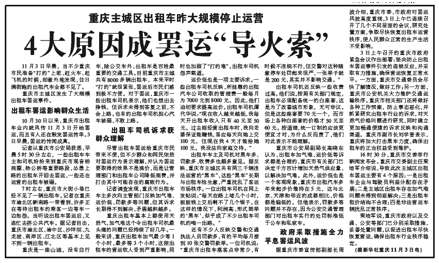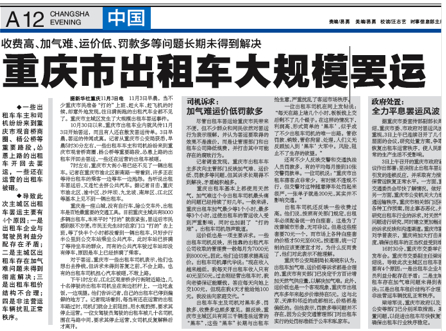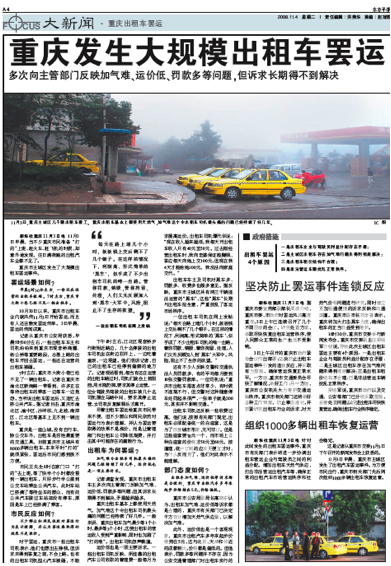Headlines and Hashtags
Taxi strikes in China highlight changing press controls
By David Bandurski — The rights movement by taxi drivers in China is a long and discouraging saga, stretching back at least to the mid-1990s. However officials in Chongqing might have characterized the root causes of last week’s taxi strike — rising fees, unlicensed taxi operators and fuel shortages — the larger story is one of systematic abuse by taxi cartels with the active help and participation of local party and government officials.
Xujun Eberlein wrote on November 9 that . . .
Evidently, China is changing. It would have been better if the government noticed the problems before an extreme measure like a strike had to be taken, but that might be too high an expectation of any government.
. . . and yet the truth is that these problems have festered in China for more than a decade.
CMP fellow Wang Keqin‘s (王克勤) breakthrough report six years ago was the boldest attempt on record to expose and grapple with these problems. It was followed by the drafting of a reform plan for the industry by the Development Research Center of the State Council that Wang says eventually fizzled in China’s vast bureaucracy.
Wang tells us too — look for an updated chapter in CMP’s volume on investigative reporting in China, to be published by Hong Kong University Press in 2009 — that former Premier Zhu Rongji (朱镕基) had criticized corruption in the taxi industry as early as 2001:
Wang found a 2001 article from China Market magazine quoting Premier Zhu Rongji, the head of China’s cabinet, as criticizing the nationwide taxi industry before a meeting of Party leaders. According to a researcher cited in the China Market report, Zhu Rongji compared the tactics of taxi companies to those of the Green Gang, a mafia-style crime group that had operated in pre-Communist Shanghai. The premier, said the article, had even sent his wife on an undercover fact-finding mission in which she rode taxis and spoke with drivers about their situation.
Chinese media reported yesterday that taxi strikes have now occurred in at least two other provinces.
The important thing to recognize first of all is that the issues underlying these taxi strikes are not newly emerging, nor are they news to party officials.
But the handling of these incidents reveals some interesting trends (and inconsistencies) in China’s press control policy. There is a great deal of ground to cover, but we’ll do our best.
When the taxi strike occurred in Chongqing last week, news coverage unfolded as a virtual textbook case in Hu Jintao’s new, more active approach to “guidance of public opinion,” what one top Chinese editor aptly called on a recent visit to Hong Kong, “Control 2.0.”
As we wrote in our analysis of Hu Jintao’s June 2008 media policy speech, the March unrest in Tibet and the May 12 Sichuan earthquake offered party leaders very different lessons about information control.
In the case of Tibet, China sealed off the region, creating a vacuum in which international media took the lead in the agenda setting process. Many leaders felt that these actions had meant that China completely lost control of the agenda.
By contrast, coverage of the Sichuan quake was relatively open, particularly during the early stages, and this enabled China to set the agenda and project a favorable international image.
Hu reiterated this point in his June speech, in which he said:
In the struggle that followed the recent earthquake disaster, we quickly released information about the disaster and the relief effort . . . earning high praise from cadres and the people, and also earning the esteem of the international community.
One of the key characteristics of Control 2.0 is the active setting of the agenda through rapid but selective news coverage by critical state media such as Xinhua News Agency, China Central Television and People’s Daily.
This is what Hu Jintao meant when he said in June that the media needs to “actively set the agenda” (主动设置议题), an echo of April remarks (post-Tibet) in which he said state media needed to keep a firm grasp on initiative in reporting (报道的主动权):
We must perfect our system of news release, and improve our system for news reports on sudden-breaking public events, releasing authoritative information at the earliest moment, raising timeliness, increasing transparency, and firmly grasping the initiative in news propaganda work.
“Initiative” on the part of core state media is complemented by traditional control tactics, notably propaganda department directives that instruct media to stay within the bounds of coverage by Xinhua, People’s Daily and company.
The Chongqing taxi strike began at approximately 5:30am on November 3. An “authoritative” Xinhua version was out by afternoon, and from that point on state news coverage drove the agenda.
News hit papers across the country the next morning, like these stories from Shanghai’s Wen Hui Bao, Changsha Evening Post, Southern Metropolis Daily (online version of newspaper page A14), Shanghai’s Oriental Morning Post . . .




. . . and many, many more — all using virtually identical versions of the same Xinhua News Agency report.
According to our database search, the Xinhua report ran in at least 100 newspapers across the country on November 4, both party and commercial. Here is a portion of that story:
“Four factors become the ‘fuse’ in the transport strike“
On the morning of November 3, as many Chongqing residents were preparing to “hail a cab” to get to work, trying to make trains and airline flights, they discovered that the taxis they generally saw running through the streets were nowhere to be seen.
Wide-scale taxi strike occurs in the primary urban area of Chongqing city.
Taxi strike affects the lives of the public.
Even since October 30, whispers of a transport strike on November 3 had passed through the taxi industry in Chongqing. On the morning of November 3 rumors of a transport strike became real.
The reporter learned from police officials in Chongqing that around 5:30am on the morning [of November 3] a number of taxi owners and drivers arrived at Chongqing’s Guanyin Bridge, Yanggong Bridge (杨公桥) and a number of other important sections of road and began urging taxis on the road to participate in a transport strike. A number of taxis still in operation were attacked and vandalized.
By around 7am no more taxis could be seen on the streets and in the alleys of Chongqing. Along a stretch of New South Road in Chongqing’s Yubei District, the reporter saw a number of disgruntled passengers waiting for taxis. When they heard there was a transport strike they hurried off to catch buses. The reporter personally witnessed that taxis were not to be seen at least six Chongqing districts . . .
Even though the transport strike has brought inconveniences for city residents, many people and web users have expressed their understanding of the strike, and believe the objective of [of drivers] is not to increase prices but to get the government and companies to lower regulatory fees and to fight against instances of corruption.
The reporter learned that taxi operators in Chongqing had on several occasions expressed to government offices that they were troubled by fuel shortages, low taxi fares, numerous penalties and other problems, but their complaints went unresolved and the problems grew worse and worse . . .
In the days that followed, editorials in most of the major commercial newspapers added some variety to “coverage” of the strike, but news coverage was solidly Xinhua News Agency.
A follow-up Xinhua news report on November 5 explained the actions taken by the Chongqing government to resolve the strike:
Xinhua News Agency, Chongqing, November 4 (reporters Wang Jintao, Zhu Wei) — The reporters learned from the Chongqing Committee of Communications (重庆市交委) on the 4th that by 2pm on the 4th half of the taxis in the principal city area had resumed operations. A spokesperson from the Chongqing Municipal Government said on the 4th that the raising of “taxi portions” (份儿钱) [levied on drivers] by taxi companies without first seeking [government] approval was an illegal practice, and the city government has decided to staunchly correct this practice of daring to raise industry fees, instructing taxi companies to return “taxi portions” to their 2007 level. As to this, a number of taxi companies have expressed their support [for this measure].
Liang Peijun (梁培军), head of the Chongqing Committee of Communications, said that by 2pm on the 4th half of the city’s taxis had resumed operations. Chongqing now has 34 taxi companies with fleets of 100 or more vehicles, and a total of close to 8,000 taxis.
But the reporters saw that on the streets the majority of taxis still had their overhead lights switched off because they were afraid of [their cars] being vandalized or intercepted. The reporters also learned that a number of working taxis are being operated by taxi company personnel, relatives, friends and other relief drivers.
Liang Peijun said that in order to get taxis back on the road taxi companies had pledged to drivers that they would bear all costs stemming from vandalization and that they would waive today’s “taxi portions.” But a number of drivers continued to fear for their safe operation.
Concerning the cessation of operations by taxis in the city, a spokesperson for the Chongqing Municipal Government said the causes of the incident were natural gas refueling difficulties, the operation of illegal taxis and a number of other factors, but the primary reason was as 50 to 70 yuan increase this year in the daily “taxi portion” [charged to drivers] by taxi companies [in the city], resulting in an annual income decline of more than 20,000 yuan for taxi operators. This placed serious pressure on taxi drivers, exacerbated their difficulties, and caused this social incident.
After the incident occurred, the Chongqing Party Committee and the city government looked earnestly into the matter. The Chongqing government said formally that the raising of “taxi portions” (份儿钱) [levied on drivers] by taxi companies without first seeking [government] approval was an illegal practice.
The series of Xinhua reports on the Chongqing taxi strike is important evidence of the changing nature of media control in China, of the emergence of Control 2.0. But we can also glimpse important changes in the Xinhua coverage itself.
One of the most noticeable changes is the use by Xinhua of the term “transport strike,” or bayun (罢运), which points clearly to a rights struggle and is far less neutral in tone than the “mass incident” designation generally used for such news by state media.
If the business of media control was business as usual in China, Monday’s taxi strike in Chongqing might have become just another obscure “mass incident” (群体性事件) swept onto the dust heap of official party statistics. But this time Xinhua does not flinch from the slightly more incendiary “strike,” and the word is promoted to the headline at many newspapers.
For the record, this is not the first time the term “transport strike” has been applied in China’s media, but it does seem to be the first time it has been used in authoritative state media news releases.
In the past, party media have almost universally used more ambiguous or sanitized terms like “ceased operation”, or tingyun (停运), to refer to strikes by taxi drivers — the rare exception is Guangdong’s more liberal Nanfang Daily. When protests staged by taxi drivers have been reported, as several have since the turn of the century, it is commercial media that have stepped up and used the term “strike.”
When drivers staged protests in Ningxia’s Yinchuan in July 2004, the story was carried in close to 60 papers nationwide. But only 16 used the term “transport strike” to refer to the Yinchuan incident, and with the exception of Xi’an Daily and Nanfang Daily, all were commercial newspapers (or hybrids): Weekly Digest (每周文摘), Yangcheng Evening News (羊城晚报), 重庆晨报, 华西都市报, New Express (新快报), Beijing Youth Daily (北京青年报), Lanzhou Morning Post (兰州晨报), Youth Daily Shanghai (青年报上海), Chengdu Evening News (成都晚报), Chongqing Evening News (重庆晚报), and Southern Metropolis Daily (南方都市报).
Returning to coverage of the Chongqing strike last week, a subsequent face-to-face consultation between Chongqing officials and taxi drivers, broadcast live on November 6, added another layer to the official version of the story at mid-week and showed just how effective the party’s new hybrid approach to information (essentially, throwing open the windows for state media and closing the doors on commercial media) can be.
The day of the live-broadcast consultation, a veteran journalist at the Beijing Evening News commented on changes in state media coverage of the taxi strike story. He noted the dominance of Xinhua reports and the use of the term “strike.”
But the journalist also suggested that the party’s version of the root causes of the strike was insufficient. In a reference to China’s recent poisonous milk scandal, he wrote that the “problem of management fees (管理费) is the melamine of the taxi industry [in China], and if this festering problem isn’t dealt with then problems will likely persist”:
I trust that a lot of readers of this paper could not put down the report yesterday about taxi drivers in Chongqing staging a strike. I’m confident that I read a few reports more [on this] than your average reader, and aside from this report [as it appeared in the Beijing Evening News] I read a number of other papers. The content was largely the same, bearing only slight differences, or no differences at all, and they were all according to Xinhua News Agency dispatches, or the “Xinhua viewpoint” (新华视点). The headlines were somewhat different, like “Chongqing taxis hold large-scale strike,” or “Collective strike by Chongqing taxis,” etc.
This was an impartial, objective and rather detailed and truthful news report with a high degree of credibility. As a journalist with thirty years of experience, I saw a number of things that were well worth exploring, and I want to share these with readers.
According to the Xinhua report “a wide-scale taxi strike occured in the primary urban area of Chongqing.” According to convention, we generally avoid mention of the term “transport strike” (罢运) or “workers strike” (罢工) in news reports because these have a rather obvious tint of class struggle about them. For events of this nature, which of course are quite normal occurrences in many countries, we generally append the term “mass incidents” (群体性事件). But the problem with this term “mass incidents” is its total lack of specificity. What kind of “mass”? Which “mass”? “Transport strike” is quite clear by comparison — it means that the taxi drivers have gone on strike, and there’s no ambiguity, no mistaken impression that taxi companies are also taking part [this is drivers against companies, in other words]. Ordinarily, transport strikes or work strikes entail workers upholding and pleading for their own economic rights against the government or companies.
This is precisely the case in this Chongqing taxi strike. The Xinhua News Agency report says: “Even though the transport strike has brought inconveniences for city residents, many people and web users have expressed their understanding of the strike, and believe the objective of [of drivers] is not to increase prices but to get the government and companies to lower regulatory fees and to fight against instances of corruption.”
. . . Liang Peijun (梁培军), deputy head of the Chongqing Committee of Communications said in his analysis of the four reasons behind the transport strike that the primary reason was a conflict between drivers and taxi companies over distribution of payments. This analysis is accurate, but it is insufficient, falling short of the key source of conflict. The problem of management fees (管理费) is the melamine of the taxi industry [in China], and if this festering problem isn’t dealt with then problems will likely persist with periods of varying intensity. This transport strike could be considered a rather intense case [of manifestation of underlying tensions].
As Xinhua continued to dominate the news, and the facts therefore remained unchanged, one could only turn to the editorial pages for fresher voices.
On November 9, for example, a professor from Shanghai’s Fudan University wrote an editorial in Southern Metropolis Daily called, “Why Is It That [They] Can Resolve Their Problems Only By Striking?,” that urged the government to look into the question of why nothing was done earlier about problems in Chongqing’s taxi industry:
I noticed that the government in Chongqing has issued a stern notice to those lawbreakers who thwarted the normal operations of the city [by striking violently], and that those who violated the law must face the necessary punishment. This is completely understandable. But we should distinguish those extreme acts that occured in the midst of a “transport strike” set off because relevant government offices did not take timely action. Specifically, we should draw a line before and after the government took action. The government cannot escape blame for those acts that took place before this line, and so it cannot unilaterally seek responsibility for them. And as for the long period of inaction and negligence on the part of departments in charge [transportation department, etc], responsibility should be sought according to the law.
Judging by the example of Chongqing, one might have supposed protests by taxi drivers this week in Hainan and Gansu would be handled in much the same way, with Xinhua News Agency monopolizing the facts. So far, that doesn’t seem to have entirely happened.
On the first day of coverage yesterday, some reports in commercial media were dominated by official news. For example, the Chongqing Evening Post, a commercial newspaper in the city where last week’s taxi strike occurred, sourced its news from Xinhua and People’s Daily.
In a separate report on the Sanya strike yesterday, The Beijing News relied on reports from Xinhua News Agency but added details from Hainan Special Zone News (海南特区报) and Nanguo Metropolis Daily (南国都市报). The paper’s news coverage was accompanied by an editorial in which Liu Hongbo (刘洪波) expressed the hope that moves to resolve the disputes in Chongqing and Sanya signaled that China has moved away from violent confrontation and into an era of rational negotiation between various interests.
Giving today’s coverage a quick glance, it seems there is little variety in news coverage, a suggestion that perhaps the party has reigned in any independent reporting — that is, reporting NOT by Xinhua. But we’ll need a bit of time to see how coverage plays out.
Once again, it is in the editorial pages that things are really getting interesting. One area in particular is the discussion of demands by taxi drivers that they be allowed to form their own association to defend their rights and interests.
Here, for example, is Yang Tao (杨涛) on page 30 of today’s Southern Metropolis Daily, in a piece whose call against taxi industry cartels bears strong echoes of Wang Keqin’s 2002 investigative report into the industry:
. . . And so I think that if we want to change this chaotic state of affairs in which “taxi portions” (份儿钱) are far too high, then we must break through the monopolization of the taxi industry, thoroughly introducing competitive mechanisms, dissolving taxi companies [which mediate licensing and control access to the industry], dissolving “taxi portions” and allowing drivers to be regulated directly by the government . . .
Another advantage of giving taxi drivers “their own organization” is that if they are legally organized then this will prevent the emergence of underground organizations [such as taxi mafias], benefitting social order and stability. Those taxi drivers who participated in taxi strikes to uphold their own vested interests “attacked and vandalized” “more than 10 taxis normally operating” because they hoped these drivers would not “hitch a ride,” that they would not seek to benefit from their misfortunes and that they could unite in action. If a lawful organization existed to coordinate their activities, it might serve as a check on its members and this sort of vandalism might be prevented.
MORE CHINESE EDITORIALS:
“Why [Official] Labor Unions Weren’t Part of the Picture in the Taxi Strikes,” Oriental Morning Post, November 13, 2008
“I’m Afraid the ‘Wenzhou’ Model Won’t Work Either,” Oriental Morning Post, November 13, 2008
“It’s Time for Unified Reform of the Taxi Management System,” The Beijing News, November 13, 2008
“Can Sanya’s Taxi Brothers Actually Form and Organization?” China Youth Daily, November 13, 2008
“Is it Enough that the Mayor of Sanya Has Apologized?” RedNet (Hunan), November 13, 2008
“Leading Cause of Transport Strikes is Industry Monopoly,” Qianlong.com, November 13, 2008 (quotes CMP fellow Zhang Ming on taxi monopolies)
“Taxi Management Must Seek Elimination of Hidden Costs,” Shanghai Morning Post, November 13, 2008 (alludes to problem of taxi cartels with government connections)
[Posted by David Bandurski, November 12, 2008, 3:17pm HK]




















